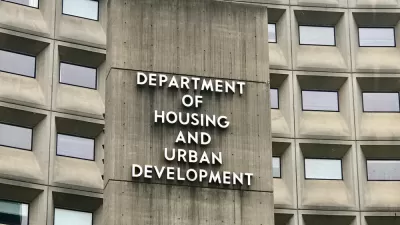After beefing up the 1968 Fair Housing Act, the feds are guiding cities to compliance.
Housing agencies nationwide are still adapting to new guidelines and more stringent enforcement issued last year by the Department Housing and Urban Development. NextCity fellow Oscar Perry Abello offers an optimistic take on how the Affirmatively Furthering Fair Housing (AFFH) rule will affect municipal housing policy.
AFFH clarifies and strengthens the 1968 Fair Housing Act, which "aims to combat segregation in American cities and tackle pockets of concentrated poverty that disproportionately impact people of color." It didn’t have much in the way of teeth in the past, Abello notes; the anti-segregation measures were seen by President Nixon and supporters as "forced integration."
Now HUD is requiring housing agencies to conduct "fair housing assessments," and intends to withdraw funding from municipalities that can’t prove their policies are non-discriminatory. That hasn’t always been the case, with failure to distribute affordable housing around cities at times resulting in "subsidized segregation."
To help cities meet these expectations, HUD is partnering with local and national non-profits to introduce a new mapping tool that visualizes geographic data on income, race and national origin, environmental quality, access to jobs and transportation, and more. "The hope was that easier and more visual access to the data, combined with deeper community engagement requirements, would start to reshape how state and local governments used their HUD resources," Abello explains.
AFFH, coupled with a Supreme Court decision expanding the definition of housing "discrimination," drew no shortage of controversy: One New York Times columnist even warned the two actions would drive middle-class whites, forced to accept affordable housing in their neighborhoods, to the Republican Party. Others worried the enforcement measures didn't go far enough to effect meaningful change.
Abello quotes experts who recommend that HUD avoid a one-size-fits all approach to implementing the new policy, instead allowing space for differing strategies based on the needs of particular communities:
Many have focused on the new rule’s potential to support more families on housing assistance with moving to wealthier neighborhoods, giving them access to better schools, cleaner air or better amenities. That may happen, but if the goal is to make sure ZIP code doesn’t determine access to fair housing and opportunity, a more balanced approach may be necessary.
Recently, for instance, HUD rejected a San Francisco plan to reserve nearly half of new affordable housing units for people already living in the neighborhood. The plan was crafted to help local black families remain in gentrifying areas of the city, but HUD categorizes all "neighborhood preference" plans as exclusionary.
More on the rules, and the non-profits helping cities to implement them, at NextCity.
FULL STORY: New HUD Rules Shouldn’t Leave Behind Disinvested Neighborhoods

Planetizen Federal Action Tracker
A weekly monitor of how Trump’s orders and actions are impacting planners and planning in America.

Restaurant Patios Were a Pandemic Win — Why Were They so Hard to Keep?
Social distancing requirements and changes in travel patterns prompted cities to pilot new uses for street and sidewalk space. Then it got complicated.

Map: Where Senate Republicans Want to Sell Your Public Lands
For public land advocates, the Senate Republicans’ proposal to sell millions of acres of public land in the West is “the biggest fight of their careers.”

Maui's Vacation Rental Debate Turns Ugly
Verbal attacks, misinformation campaigns and fistfights plague a high-stakes debate to convert thousands of vacation rentals into long-term housing.

San Francisco Suspends Traffic Calming Amidst Record Deaths
Citing “a challenging fiscal landscape,” the city will cease the program on the heels of 42 traffic deaths, including 24 pedestrians.

California Homeless Arrests, Citations Spike After Ruling
An investigation reveals that anti-homeless actions increased up to 500% after Grants Pass v. Johnson — even in cities claiming no policy change.
Urban Design for Planners 1: Software Tools
This six-course series explores essential urban design concepts using open source software and equips planners with the tools they need to participate fully in the urban design process.
Planning for Universal Design
Learn the tools for implementing Universal Design in planning regulations.
Heyer Gruel & Associates PA
JM Goldson LLC
Custer County Colorado
City of Camden Redevelopment Agency
City of Astoria
Transportation Research & Education Center (TREC) at Portland State University
Camden Redevelopment Agency
City of Claremont
Municipality of Princeton (NJ)





























